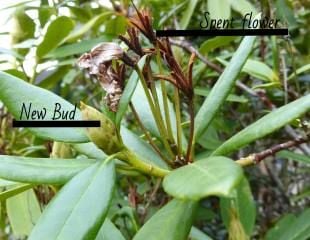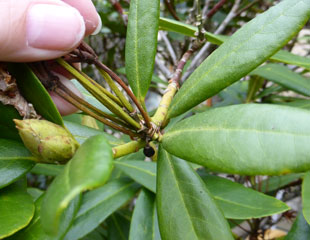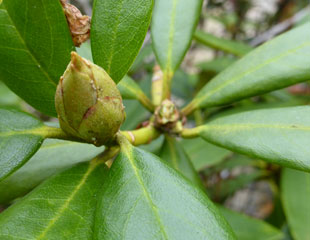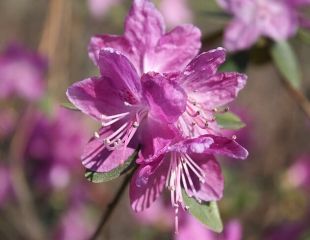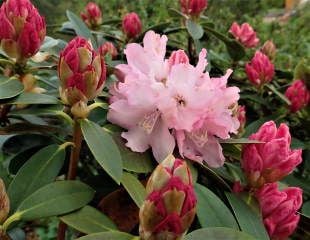
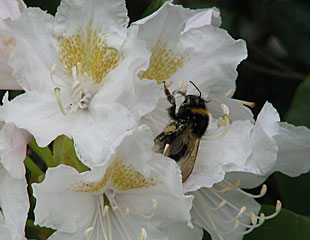
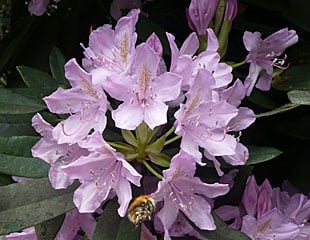
How to Grow Rhododendrons
Rhododendrons can be deciduous or evergreen, although most of the most popular garden varieties are evergreen. Rhododendrons are undemanding and easy to grow shrubs. Their only essential requirement is acid soil, which is a soil in which the pH is 7.0 or below. As illustrated in the images above Rhododendron have showy blooms which are attractive to bees as an excellent source of nectar. Rhododendrons and Azaleas will not grow well in alkaline soil. This is not just a case of growing better in acid soil, Rhododendrons simply will not grow in any soil other than acid soil. Most Rhododendrons flower from March-May.
It is easy to be put off by Rhododendrons, which in recent years have had a bad press. It is correct that the common Rhododendron, known as pontic rhododendron, is a menace, and you can identify it from the image above right. In the wild this variety of Rhododendron is invasive, out competes native plants and is to be avoided. More information about pontic rhododendron below.
However, Rhododendrons are a vast genus of over 900 in all shapes, sizes, and heights. There are suitable shrubs for many gardens. Rhododendrons come in a wide colour range: pink, purple, yellow, white, red and orange, just about everything. The colours are bright and bold; a Rhododendron in full bloom is eye-catching. Rhododendrons are originally a woodland plant and dappled shade is their native conditions. That said, Rhododendrons are tough and will grow anywhere in the right (acid) soil. If the growing position is very sunny, the smaller compact and deciduous varieties will do best.
Because Rhododendrons are such a wide genus with many varieties, it is important to check the plant label for information about the eventual size. There are many on the market which are compact, especially the Azaleas.
If you are thinking of growing Rhododendrons, but unsure of your soil type, you can do one of two things. You can buy a soil kit to test the Phd of your soil, which will tell you if it is acidic: a result of pH 7 below is acid soil, pH7 neutral and pH7+ alkaline soil. Alternately, you can check out your neighbour's garden and see what's growing there. If there are Rhododendrons and Azaleas in the neighbourhood, the chances are your soil will be similar.
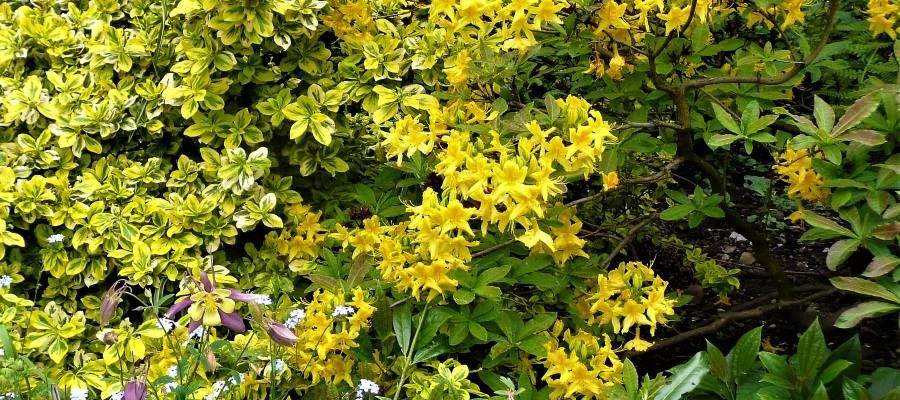
Scented Rhododendron Luteum and Rhododendron combinations
Rhododendrons are spectacular as single shrub, or massed together and mix well with other shrubs. The image above is a great, a bold spring combination of strong yellow Rhododendron Luteum, combined with the variegated Euonymus fortuneii 'Emerald Gold' and flowering Aquilegia 'Swan Lavender' which makes a really bright spring combination.
There are a few scented Rhododendrons which are often the deciduous varieties. R. Fragrantissimum which is only hardy down to -10 and bears white flowers. R.Luteum which has garden merit award, it is a fully hardy deciduous azalea growing up to around 2.5m/8ft. R. Loderi has coral pink flowers, Dufthecke white, Inkarho is evergreen and fragrant with white flowers and finally Antelope which is a sun loving hardy deciduous azalea.
If Rhododendron is not the shrub for you, check out shrubs and bushes; spring flowering shrubs; summer flowering shrubs; shrubs with autumn and winter interest; and evergreen shrubs.
How to Prune Rhododendrons
Some Rhododendrons can get large over time and outgrow their space. Although a very woody shrub, it is possible to hard prune Rhododendrons, even severely, and they will grow back. Initially, they may look a bit of an eyesore with bare wood, but fairly soon the Rhododendron will produce fresh growth.
Rhododendrons respond well to pruning, and the best time to do this is mid summer after flowering. There is always a risk to the next season's flowers, but after that the shrub will pick up. The same applies if you hard prune, initially it will look decimated, as in the images below, but fresh growth appears and the shrub soon gets re-established. This is helpful if the shrub is too big, or overhanging a path or creating too much shade. Cut back how you want and it will regrow. The image left shows a Rhododendron after a hard prune, centre growing back and image right, there is no bare wood visible after a prune.
Rhododendron after being hard pruned
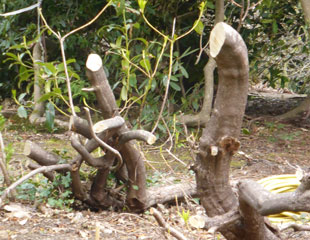
Rhododendron growing back after being hard pruned
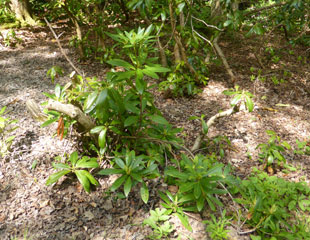
Rhododendron grown back after pruning
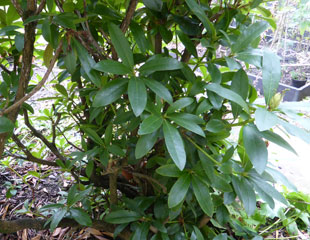
Winter flowering rhododendron
There is one variety of Rhododendron which flowers in the winter. R. dauricum ' Mid-Winter' which has a profusion of pink /mauve flowers from December and January. (image credit Wiki Anneli Salo)
It is upright form and can reach 1.5m in good growing conditions which are acid soil and dappled shade. It makes an excellent winter flowering shrub. It is fully hardy and as with all woodland plants, a mulch of leaf mould is ideal.
This variety has the RHS award of garden merit and, whilst not commonly grown, there are quite a few suppliers.
Warning about Rhododendron ponticum
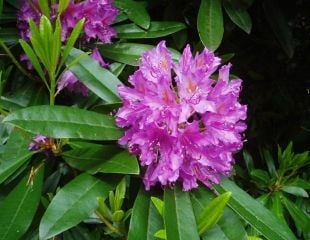
This is a plant mug shot, and this plant is a thug and carries a huge gardening health warning. This Rhododendron is extremely vigorous and growing out of control in parts of our countryside, such as the Snowdonia national park. Once established, it is very difficult to remove. Each plant can produce a large quantity of seed and so it has, and does, escape the garden setting and into the countryside where it is adverse to wildlife and natural flora. There is also a lot of debate about whether Nectar from Rhododendrons, especially R.ponticum is toxic to bees and the answer is complex.
How to dead head a Rhododendron
There is a view that Rhododendrons can look untidy after flowering and that dead heading encourages better buds. If you are a keen gardener, you can dead head after flowering, which is said to encourage better blooms the next year and certainly looks better, but be careful not to remove the embryo bud forming behind. The important point is to be clear about what is old bud and new bud. The images below illustrated, first left has the spent flower and the new bud; the second centre image shows removing the old bud and right the plant with just the new bud.
page updated 16.01.2024
